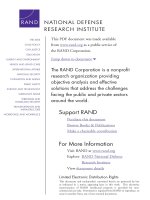Cytoskeleton regulators in the control of corneal fibrosis
Bạn đang xem bản rút gọn của tài liệu. Xem và tải ngay bản đầy đủ của tài liệu tại đây (7.3 MB, 147 trang )
i
Acknowledgements
I would like to express my sincere gratitude to Professor Roger W. Beuerman for his
supervision and guidance throughout this project. I am grateful for his comments and
advice. I would like to thank all the staff of SERI especially Sia-Wey Yeo, Wing-Sam
Lee, Jennifer Ng, Queenie Tan, Candice Ho, Jia Lin, Wan-e Lim and Dr. Amutha
Veluchamy Barathi, who assisted me in many ways. My work was supported by the
grant: National Research Council of Singapore grant (R739/23/2010) and Singhealth
Foundation grant (R835/30/2011).
I would like to thank my family for their love and support throughout my endeavours.
ii
TABLE OF CONTENTS
CHAPTER I. INTRODUCTION…….………………………………………………. 1
1 Cornea structure…………………………………………………… ……… 1
1.1.1 Corneal stroma structureh …………………………………………… ……. 1
1.1.2 Corneal stroma keratocytes…………………………………………………. 2
1.1.3 Cytoskeleton in biology………………………………………………… …. 3
1.1.4 Cytoskeleton regulators in biology…………………………….……………. 3
1.2 Corneal fibrosis as an adverse outcome…………………… ………………. 3
1.3 Corneal stroma keratocytes in corneal fibrosis……………………………… 4
1.4 Mediators trigger corneal fibrosis……………………… …………………. 5
1.4.1 TGF-β1 induced fibrosis……………………………………………………. 5
1.4.2 TGF-β1 induced corneal fibrosis………………………… ………………. 6
1.5 Cytoskeleton in fibrosis……………………………………………….……. 7
1.5.1 Cytoskeleton regulators in fibrosis…………………………………………. 8
1.6 Current treatment of corneal fibrosis………………………….……………. 10
1.7 Answering the Experimental Questions……………………………………. 12
1.8 Hypothesis…………………………………………………………….……. 12
1.8.1 Specific aim…………………………………………………………………. 13
CHAPTER II. MATERIAL AND METHODS…………………………………… 14
2.1 Ethics……………………………………………………………………… 14
2.2 Anterior Keratectomy Procedure……………………………………………. 14
2.3 Animal Experimental Groups………………………………………… …… 15
2.4 Gold-Chloride Procedure………………………………………………….…. 16
iii
2.5 Cytoskeleton Regulators RT² Profiler™ PCR Array………………………… 16
2.6 Moesin siRNA in vivo delivery…………………………………… ………. 17
2.7 List of laboratory techniques………………………………………… ……. 18
2.7.1 Preparation of tissue…………………………………………………………. 18
2.7.2 Use of exogenous protein……………………………………………………. 18
2.7.3 Histological Evaluation …………………………….………………………. 19
2.7.4 Immunochemistry……………………………………………………… …. 21
2.7.5 Imaging…………………………………………………………………… 22
2.7.6 RNA Extraction and quantification……………………………… ………. 22
2.7.7 Reverse transcription and Polymerase chain reaction…………………… 24
2.7.8 Real time RT-PCR………………………………………………………… 25
2.7.9 Total protein extraction……………………………………………………. 27
2.7.10 BCA protein assay………………………………………………………… 28
2.7. 11 Western blot analysis……………………………………………………… 28
2.8 Statistical analysis…………………………………………………………. 30
Chapter III. TGF-β1-induced corneal fibrosis…………………………………… 31
3.1 Phenotypic changes of corneal stroma keratocytes in response to the anterior
keratectomy…………………………………………………………………. 31
3.2 Effect of various dosing regimes of topical application of TGF-β1 on the
transformation of corneal keratocytes-to-myofibroblasts in corneal fibrosis in
vivo……………………………………. ……………………………………. 33
3.3 TGF-β1 induced transformation of corneal stroma keratocytes-to-
myofibroblasts in the corneal fibrosis……………………………….………. 39
3.4 Up-regulation of cytoskeleton regulators in corneal fibrosis in vivo……… 41
iv
Chapter IV. Moesin and fibrosis………………………………………………………. 46
4.1 Moesin functions in cytoskeleton……………… ……………………………. 46
4.2 Moesin in fibrosis…………………………………………………… ………. 46
4.3 Co-localization of moesin and α-SMA within corneal stroma keratocytes in
corneal fibrosis………………………………………………………………… 47
4.4 Characterization of moesin expression in the corneal fibrosis………………… 49
4.5 Role of moesin in the corneal fibrosis in vivo…………………………………. 51
4.5.1 In vivo delivery of moesin siRNA into the cornea after an anterior
keratectomy…………………………………………………………………… 51
4.5.2 The transformation of corneal stroma keratocytes-to-myofibroblasts in the
corneal fibrosis is moesin-dependent…………………………………………. 56
4.5.3 Corneal haze development in the injured cornea……………………………… 60
Chapter V. Moesin and signaling in corneal fibrosis 63
5.1 Introduction to Smad signaling in fibrosis……………………………………. 63
5.2 Effect of TGF-β1 on the activation of Smad 2 and Smad 3 in the corneal
fibrosis………………………………………………………………………… 64
5.3 Effect of moesin on TGF-β1-stimulated activation of Smad2 and Smad3 in
corneal fibrosis…………………………………………………………………. 68
Chapter VI. Discussion………………………. 72
6.1 Summary of findings………………………………………………………… 72
6.1.1 Transformation of corneal stroma keratocytes to myofibroblasts in corneal
fibrosis…………………………………………………………………………. 72
6.1.2 Effect of TGF-β1 on corneal fibrosis……………………….…………………. 73
6.1.3 Role of moesin in the corneal fibrosis in vivo…………………………………. 73
6.1.4 Signaling pathway relevant to the corneal fibrosis regulated by moesin in
Vivo…………………………………………………………………………… 75
6.2 Limitations…………………………………………………………………… 77
v
6.3 Clinical application……………………………………………………………. 79
6.4 Future studies………………………………………………………………… 81
Chapter VII. References……………………………………………………………. 85
Chapter VIII. Appendices………………………………………………………… 131
Appendix A: Experimental animal groups……………………………………………. 132
Appendix B: Moesin siRNA sequences………………………………………………. 132
Appendix C: Antibodies………………………………………………………………. 132
Appendix D: PCR primers……………………………………………………………. 133
Chapter X. Supplementary…………………………………………………………… 134
A. Grants: ……………………………………………………………………………… 134
B. Patents………………………………………………………………………………. 134
C. Presentations at Conferences……………………………………………………… 134
D. Publications…………………………………………………………………………. 136
vi
SUMMARY
The avascular cornea accounts for about two-thirds of the total refractive power of the
eye,
therefore maintenance of corneal transparency is critical for focusing light onto
the retina. The impact on vision is highlighted by the finding that corneal scar as a
contributor to “corneal blindness” is the third leading cause of blindness world-wide.
Corneal scar may develop as sequel to infections and a wide spectrum of corneal
stromal injuries such as refractive surgery (LASIK, etc.). Currently, corneal
transplantation is the major treatment regime for corneal scar. To develop more
specific medical therapies or as an adjunct to surgery to prevent scar formation, the
regulation of corneal scar must be understood.
Fibrosis is the cellular process that leads to the formation of scar. A strong association
of fibrosis with “cytoskeleton regulators” suggests this class of proteins that links the
intracellular cytoskeleton with the extracellular environment may be a target for
therapeutic development; however, as this is a large group of proteins, evidence for
involvement of specific members of this class of proteins in the corneal fibrosis has
not been developed. Recently, interest in the ERM (ezrin/radixin/moesin) family
members has shown that these proteins are the organizer of membrane domains and
act as links to the cytoskeleton as well as signalling pathways involved in many
cellular processes.
Cytoskeleton disruption agents have been shown to prevent
fibrosis may involve this family of proteins.
Our clinical target is the early phase of corneal wounding, before an opaque corneal
scar forms. In response to corneal injury, the transformation of corneal stroma
keratocytes-to-myofibroblasts is predominently responsible for the corneal fibrosis.
vii
To define the in vivo role of specific cytoskeleton regulators in mediating the corneal
fibrosis, a mouse model with corneal fibrosis stimulated by the anterior keratectomy
was established. TGF-β1 was topically applied to accelerate the corneal fibrosis
process since it activates corneal stroma keratocytes to a myofibroblast phenotype
expressing α-SMA accompanied by altered expression patterns of ECM components.
The main results of the present study are that (1) in the corneal fibrosis, moesin was
identified as the most highly induced gene among the 84 cytoskeleton regulator genes
using cytoskeleton regulators RT² Profiler™ PCR array (Chapter III 3.4); (2) The up-
regulation of moesin in the corneal fibrosis was confirmed by RT-PCR (Chapter III
3.4) and western blot (Chapter IV 4.4) in a time-dependent manner; (3) the
appearance of myofibroblasts was analyzed by examining α-SMA expression.Dual
immunofluorescent staining showed that moesin colocalized with α-SMA within
corneal stroma keratocytes in the corneal fibrosis (Chapter IV 4.3); (4) Up-regulation
of α-SMA and moesin in the corneal fibrosis was reduced by moesin siRNA (Chapter
IV 4.5.1 and 4.5.2); (5) Moesin siRNA reduced corneal opacification in corneal
fibrosis (Chapter IV 4.5.3); (6) Activation of Smad 2 and Smad 3 in corneal fibrosis
was reduced by moesin siRNA (Chapter V 5.3).
In conclusion, moesin siRNA decreased the transformation of corneal stroma
keratocytes-to-myofibroblasts in the corneal fibrosis, as defined by the expression of
α-SMA, through the reduction of activated forms of Smad 2 and Smad 3. Moesin may
be a potential drug target for inhibiting corneal fibrosis and details of moesin-related
signaling pathways would be critical for understanding corneal fibrosis.
viii
LIST OF TABLES
1. Experimental animal groups…………………………………………… 133
2. List of moesin siRNA sequence……………………………………… 133
3. List of antibodies……………………………………………………… 132
4. List of PCR primers…………………………………………………… 132
5. Various dosing regimes for topical application of TGF-β1 on the corneal
stroma after the anterior keratectomy…………………………… 35
ix
LIST OF FIGURES
1 Histological analysis of corneal wound healing after an anterior
keratectomy……………………………………………………………………20
2 Phenotypic changes of corneal stromal keratocytes in response to
the anterior keratectomy ………………………………………… 32
3 Effect of various dosing regimes for TGF-β1 on the transformation of
corneal keratocytes-to-myofibroblasts, as defined by the expression of α-SMA
in the corneal stroma after the anterior keratectomy 35
4 Keratocyte-to-myofibroblast transformation induced by topical application
of TGF-β1, as defined by α-SMA expression 40
5 Results for the response of cytoskeleton regulators to topical application
of TGF-ß1 after an anterior keratectomy at PO day 1 analyzed by
RT² Profiler PCR-array ……….………………………………………………42
6 RT-PCR quantification of mRNA levels for cytoskeleton regulators induced
by topical application of TGF-ß1 following an anterior keratectomy 44
7 Dual immunofluorescent staining demonstrated that moesin co-localized with
α-SMA within corneal stroma keratocytes in the corneal fibrosis…………… 48
x
8 Up-regulation of moesin in the corneal fibrosis……… ……………………50
9 Distribution of fluorescein–labeled moesin siRNA after in
vivo delivery of moesin siRNA by iontophoresis into the cornea…………….52
10 Effect of moesin siRNA on the expression of moesin in the
corneal fibrosis ……………………………………………………………….54
11 Effect of moesin siRNA on the transformation of corneal
keratocytes-to-myofibroblasts in the corneal fibrosis ……………….……… 58
12 In vivo slit lamp macroscopic observation of the cornea in group 2-AK
and group 5-AKTSi……………………………………………………………61
13 Effect of TGF-β1 on Smad 2 activation …………………………………… 65
14 Effect of TGF-β1 on Smad 3 activation ………………………………… …67
15 Effect of moesin on Smad 2 activation …………………… ……………….69
16 Effect of moesin on Smad 3 activation ………………….………………… 70
xi
LIST OF ABBREVIATIONS
NC – Normality control
α-SMA - alpha smooth muscle actin
MMC –mitomycin C
ERM- eosin radixin moesin
PO – post operative
TGF- Transforming Growth Factor
ECM -extracellular matrix
siRNA- short interfering ribonucleic acid
ANOVA -Analysis of variance
PBS- phosphate buffered saline
BSA -bovine serum albumin
DEPC -Diethyl Pyro carbonate
SDS- sodium dodecyl sulphate
dNTP -deoxy nucleoside (5’-) tri phosphate
DTT 1, 4-dithiothreitol
RNA Ribonucleic acid
cDNA -complimentary deoxyribonucleic acid
PCR -Polymerase Chain Reaction
RT-PCR Reverse Transcriptase - Polymerase Chain Reaction
1
CHAPTER I. INTRODUCTION
1.1 Cornea structure
The cornea is an avascular tissue and is comprised of five layers: The corneal
surface consists of a multi-layered (5-7 cell layers) non-keratinized, stratified
squamous epithelium, which is separated from the thick collagenous stroma layer
by a condensed layer of collagen-Bowman’s layer. Backing the stroma and
separating it from the anterior chamber of the eye is a simple squamous
monolayer-endothelium, which consists of a monolayer of cells attached to the
stroma via a thin acellular layer known as Descemet's membrane (Beuerman RW
et al 1998). These tissues can be separated easily from each other because each of
these tissues is homogeneous in cell type and arranged in the simple layers.
Therefore the cellular events that occur during corneal wound healing can be
documented precisely with these unique structural features (Weimar V et al 1960).
1.1.1 Corneal stroma structure
Corneal stroma constitutes about 90% of the total thickness of human cornea. The
stroma composed with corneal stroma keratocytes, extracellular matrix, and
bundles of highly ordered collagenous fibers aligned in parallel layers with
respect to one another (Meek KM et al 2001 and 2004; Funderburgh JL et al 1997
and 2000; Dunlevy JR et al 2000; Chakravarti S et al 2002; Kao WW et al 2002).
The precise arrangement of keratocytes and extracellular matrix components in
the corneal stroma are important for corneal function because they account for the
major contribution towards corneal curvature, refractive power and transparency,
2
and allow free passage of light (Ishizaki M et al 1994; Maurice DM et al 1957 and
1962).
1.1.2 Corneal stroma keratocytes
Corneal stroma keratocytes are neural crest-derived cells and major cell type
reside in the corneal stroma which synthesize extracellular matrix during
development and maintain homeostasis in adults. Møller-Pedersen and coworkers
(1994 and 1997) showed that human cornea contains 2.0-3.5 million stroma
keratocytes. Light passes through up to 100 layers of light-scattering stroma
keratocytes when traveling through human cornea (Møller-Pedersen et al 2004).
Corneal stroma keratocytes are a principle source of light scattering (Møller-
Pedersen et al 2004), and thus play an essential role in the maintenance of corneal
transparency (Hay ED et al 1980).
Normal corneal stroma keratocytes are quiescent, flattened and sparsely
distributed between the collagen lamellae of the corneal stroma (Nishida T et al
1988; Smelser GK et al 1965; Smith JW et al 1969); filamentous actin in normal
corneal stroma keratocytes is not organized into the stress fibers (Netto MV et al
2006a). Following corneal stroma injury, corneal stroma keratocytes adjacent to
the wound edge transform into the repaired cells-myofibroblasts (Martin P et al
1997; Fini ME et al 1999; Matsuda H et al 1973), which is responsible for the
reduction of cornea transparency and has been identified as the predominant
biological event
responsible for corneal fibrosis (Netto MV et al 2006a; Mohan
RR et al 2003; Jester JV et al 1987, 1994, 1996, 1999b).
3
1.1.3 Cytoskeleton in biology
The cytoskeleton is a dynamic cell organelle which tranduces external micro-
environmental events to initiate changes in cell motility, migration and
morphological changes (Brown BK et al 2001; Pollard TD et al 2003).
Cytoskeleton contains three main components: microfilaments, intermediate
filaments, and microtubules (Heuser JE et al 1980; Fey EG et al 1984).
1.1.4 Cytoskeleton regulators in biology
Rearrangements of cytoskeleton are central to the aforementioned function of
cytoskeleton. Several studies have highlighted the importance of cytoskeleton
regulators in the control of dynamic rearrangements of cytoskeleton (Ono S et al
2007; Silacci P et al 2004; dos Remedios CG et al 2003; Maciver SK et al 2002;
Cooper JA et al 2000; Sun HQ et al 1999; Weeds AG et al 1991).
1.2 Corneal fibrosis as an adverse outcome
The precise architecture of the cornea is essential to maintain normal vision. After
corneal infection, or corneal stroma injury (ocular trauma including injury like
large epithelial debridement or alkali burns or surgery such as refractive surgery,
e.g., LASIK, etc.)
(Chen JJ et al 1990 and 1991; Jester JV et al 1995 and 1997;
Chew SJ et al 1995; Funderburgh JL et al 1989) that provide sufficient stimulus to
disrupt basement membrane, corneal fibrosis develops as a wound-healing
response, which interferes with the normal corneal structure (Saika S et al 2009)
and causes visual impairment (Jester JV et al 1997). The impact on vision is
4
highlighted by the finding that corneal fibrosis as a contributor to “corneal
blindness” is the third leading cause of blindness world-wide (Foster A et al 2005).
1.3 Corneal stroma keratocytes in corneal fibrosis
During corneal wound healing, the transformation of corneal stroma keratocyte to
differentiated myofibroblast phenotype is the hallmark of corneal fibrosis (Netto
MV et al 2006a; Mohan RR et al 2003; Jester JV et al 1987, 1994, 1996, 1999b).
Injury to the corneal stroma (penetrating keratoplasties, laser refractive surgery,
corneal trauma, keratectomy, or photoablation by excimer laser) results in the
apoptosis of the corneal stroma keratocytes in the wound region (He J et al 2008;
Fini ME et al 1999; Wilson SE et al 2002). Corneal stroma keratocytes near the
wound edge become activated (Netto MV et al 2006a) and differentiated into
spindle shaped myofibroblasts (Mohan RR et al 2003) that proliferate and migrate
towards the wound region, and repopulate the acellular wound area (Moller-
Pedersen T et al 1998a, 1998b and 1998c; Zieske JD et al 2001). That
myofibroblasts reduce corneal transparency (Wilson SE et al 2001) attributes to
three reasons: firstly, reduced intracellular crystallin production of myofibroblasts
(Jester JV et al 1999b and 1999c); secondly, myofibroblasts within the wound
region cause increased scattering of light (Jester JV et al 1999b and 1999c);
thirdly, the deposition of the fibrous tissue initiated by myofibroblasts contributes
to the regression of the refractive power (Jester JV et al 1999b and 1999c). The
appearance of myofibroblasts temporally correlates with increased amount of
rabbit corneal fibrosis (Moller-Pedersen et al 1998a and 1998b), and the
5
disappearance in myofibroblasts also correlates with reduced rabbit corneal
fibrosis (Jester JV et al 1999b).
1.4 Mediators trigger corneal fibrosis
Since the transformation of keratocytes into myofibroblasts
has been identified as
the predominant biological process
responsible for corneal fibrosis (Jester et al
1999a; Jester et al 1999b; Folger PA et al 2001; Netto MV et al 2006a; Imanishi J
et al 2000), an important issue is to characterize the mediators involved in the
regulation of this phenotype transition. The transformation of keratocytes to
myofibroblasts occurs as a consequence of multiple stimuli, but focus is put on
TGF-β1 and cytoskeleton regulators in this thesis since the cytoskeletal tension
and TGF-β1 play a main role in regulating the acquisition and maintenance of the
myofibroblast phenotype (Hinz B et al 2001b; Arora PD et al 1999a; Blaauboer
ME et al 2011; Hinz B et al 2003).
1.4.1 TGF-β1 induced fibrosis
TGF-β1 is a multifunctional regulatory cytokine and has impact on diverse
cellular activities (Sporn MB et al 1992). Under ideal circumstances, TGF-β1
leads to the normal tissue architecture remodeling; however, excessive TGF-β1
prevents myofibroblast apoptosis and contributes to a pathologic tissue repair
process- fibrosis (Zhang HY et al 1999). TGF-β1 has been linked to a variety of
the human fibrotic disease (Leask A et al 2004). For example, persistent elevation
of TGF-β1 in the kidney leads to tubulointerstitial fibrosis (Border WA et al
6
1994); increased TGF-β1 expression in chronic liver disease is a hallmark of
hepatic fibrosis (Fausto N et al 1991); TGF-β1 contributes to systemic sclerosis
which is an autoimmune disease characterized by excessive fibrosis (Liu X et al
2005). Increased amounts of TGF-β protein was observed in the lung biopsies
from patients with pulmonary fibrosis (Broekelmann TJ et al 1991). Active TGF-
β in astrocytes induces fibrosis formation (Asher RA et al, 2000). In the
experimental animal model, transgenic mice with aberrant TGF-β1 expression
developed the fibrosis of liver and kidney (Clouthier DE et al 1997).
1.4.2 TGF-β1 induced corneal fibrosis
TGF-β1 is a central mediator of corneal fibrosis (Saika S et al 2009). The
transformation of corneal stroma keratocyte to myofibroblast phenotype is a
predominant biological event responsible for the corneal fibrosis (Netto MV et al
2006a; Mohan RR et al 2003; Jester JV et al 1987, 1994, 1996, 1999b). TGF-β1
induces the transformation of corneal stroma keratocyte to a myofibroblastic state
as seen in the corneal fibrosis (Tandon A et al 2010; Jester JV et al 1999a; Kaur H
et al 2009; Karamichos D et al 2010; Carrington LM et al 2006). The expression
of α-SMA has been used extensively in research and pathology to monitor this
transformation (Carrington LM et al 2006; Darby I et al 1990; Tomasek JJ et al
2002). The TGF-β1-induced corneal fibrosis model has been extensively used to
investigate signaling pathways involved in fibrosis and to explore anti-fibrotic
therapeutic targets. In vitro, TGF-β1 induced keratocytes to develop
myofibroblastic characteristics in the cultured human (Ohji M et al 1993)
and
7
rabbit corneal keratocytes (Jester JV et al 1996 and 1999a; Masur SK et al 1996).
TGF-β1 stimulated cultured human corneal keratocytes to generate a model that
resembles in vivo human corneal fibrotic processes (Karamichos D et al 2010). In
an organ culture study,
when bovine corneas were injuried with a trephine,
myofibroblasts differentiation was induced in the corneal stroma after topical
application of 100ng/ml of TGF-β1 (Carrington LM et al 2006). Jester JV and his
colleagues (1997) showed that neutralizing antibody to inactivate TGF-β1
reduced the rabbit corneal fibrosis after lamellar keratectomy. In the rabbit eye,
fibrosis developed after photorefractive keratectomy followed by topical
application of TGF-β1 (1ug/ml) (Myers JS et al 1997).
1.5 Cytoskeleton in fibrosis
The defining criterion for myofibroblasts is the neo-expression of α-SMA (a
contractile cytoskeletal element that imparts contractile properties to the cell)
(Jester JV et al 1994) and the incorporation of α-SMA into stress fibers (Dugina V
et al 2001; Katoh K et al 2001). The transformation of keratocytes to
myofibroblasts is characterized by a change in the morphology from stellate to
spindle-shape associated with rearrangement of cytoskeleton to form stress fibers
(Jester JV et al 1994). Chaurasia SS et al (2009) suggested that rearrangement of
cytoskeleton architecture in the corneal stroma keratocytes results in increased
expression of α-SMA after rabbit corneal injury.
Myofibroblast differentiation in mesangial cells is modulated by structure and
composition of the cytoskeleton (Patel K et al 2003). Fibroblasts-to-
myofibroblasts differentiation in the lung fibrosis is controlled by cytoskeleton
8
tension (Blaauboer ME et al 2011). Cytoskeleton disruption agents prevented
fibrosis (Hordichok AJ et al 2007). Fibrosis after spinal cord injury (Hellal F et al
2011) and fibrosis associated with systemic sclerosis (Liu X et al 2005) are
decreased by microtubule stabilization.
1.5.1 Cytoskeleton regulators in fibrosis
Differentiated myofibroblasts show a significant increase in cytoskeleton
regulators content compared with fibroblasts (Dugina V et al 2001).
Malmström
et al (2004) showed that TGF-β1 up-regulated the expression of a variety of
cytoskeleton regulators (cofilin, profilin etc.). The details about several
cytoskeleton regulators which are implicated to be involved in the fibrosis are
shown below.
Mechanical stimulation is transduced from extracellular environment into
intracellular cytoskeleton of myofibroblasts through transmembrane receptors-
integrins that link to intracellular stress fibers through a variety of cytoskeleton
regulators (vinculin, talin, paxillin, gelsolin, FAK, ezrin–radixin–moesin proteins)
(Geiger B et al 2001). Phenotypic transition of human lung fibroblasts-to-
myofibroblasts induced by TGF-β1 depends on integrin signaling via focal
adhesion kinase (FAK) (Thannickal VJ et al 2003). FAK, a nonreceptor protein
tyrosine kinase, is central for the mechanoresponses, and cytoskeletal
organization (Schober M 2007; Albinsson S et al 2007; Mitra SK et al 2005).
FAK activation regulated myofibroblast differentiation by down-regulating α-
SMA, thereby preventing fibrosis (Greenberg RS et al 2006). FAK silencing was
9
demonstrated to attenuate the rise in the fibrosis in overloaded left ventricles
(Clemente CF et al 2009). Increased multifocal interstitial fibrosis was found in
mice with inactivation of FAK in cardiomyocytes (Peng X et al 2006).
Paxillin has a pivotal role in transducing signals from extracellular environment
into intracellular cytoskeleton (Turner CE et al 2000) and mediates the
rearrangement of actin cytoskeleton into contractile elements (Cowin AJ et al
2003; O’Kane S et al 1997). The ability of paxillin to modulate fibronectin
activities in wound healing may be important in the mechanism of fibrosis-free
fetal wound repair (Cowin AJ et al 2003). The expression of paxillin was up-
regulated in the transition of cardiac fibroblast to myofibroblastic phenotype
(Santiago JJ et al 2010). Fibroblasts cultured from fibrotic lesions
of patients with
systemic sclerosis (fibrotic disease) showed elevated expression of paxillin (Shi-
Wen X et al 2004).
Gelsolin and cofilin both have a critical role in the cytoskeleton rearrangement
(Sun H et al 1995; Burtnick LD et
al 1997; Kwiatkowski DJ 1986; Yin HL et al
1987). Stress fiber formation is one of the myofibroblast features (Hinz B et al
2001). Cofilin regulates stress fiber formation (Bosselut N et al 2010). In porcine
aortic cardiac valve interstitial cells, cofilin is a marker of myofibroblast
transformation and is required for SMA incorporation into stress fibers (Pho M et
al 2008). The formation of stress fibers was delayed in gelsolin-depleted cells
(Arora PD et al 1999). Mice deficient in gelsolin are protected from bleomycin-
induced fibrosis and gelsolin expression is crucial for the pulmonary fibrosis
(Oikonomou N et al 2009).
10
Profilin participates in the reorganization of the cytoskeleton (Hinz B et al 2001b).
Profilin mRNA was observed to be up-regulated by using in situ hybridization in
hypertrophic fibrosis (Wu J et al 2004).
Vinculin, moesin, and ezrin, were elevated in pulmonary fibrosis (Fukuda Y et al
1995; LeRoy EC et al 1974; Shi-Wen X et al 2004; Bogatkevich GS et al 2008).
1.6 Current treatment of corneal fibrosis
Mitomycin C (MMC) is used intraoperatively to inhibit keratocyte proliferation
and activation for
the prevention of the corneal fibrosis (Thornton I et al 2008;
Bedei A et al 2006; Camellin M et al 2004).
Although MMC reduces the sub-
epithelial fibrosis after refractive corneal surgery, several complications reported
with its topical use,
such as corneal abnormal wound healing, limbal/scleral
necrosis, endothelial damage, and loss of keratocytes (Dougherty PJ et al 1996;
Safianik B et al 2002; Rubinfeld RS et al 1992; Wu KY et al 1999).
TGF-β1 is another major target of developing anti-fibrotic strategies. Many
approaches focusing on the blockade of TGF-β1 signaling, involving interfering
the ligand or its receptor (Netto MV et al 2006a; Chang JH et al 1998; Bilgihan K
et al 2000; Nassaralla BA et al 1995; Cellini M et al 2006; Arora R et al 2005;
Sharma A 2009; Arora R et al 2005) by using antibodies (Shah M et al 1995;
Cordeiro MF et al 1999), antagonists (Grisanti S et al 2005), and nucleotide-based
methods (Cordeiro MF et al 2003), which ameliorate the fibrotic process in the
animal model of fibrosis (Ueno H et al 2000; Giri SN et al 1993; Wang Q et al
1999). For example, the development of dermal or corneal fibrosis was blocked
11
by the application of neutralizing antibodies to inactivate TGF-β (Jester et al 1997;
Shah M et al 1994; Shah M et al 1995; Moller–Pedersen T et al 1998b). However,
because TGF-β plays many essential roles in a variety of developmental and
pathological processes (Massague J et al 1998), including immune regulation,
cancer surveillance, wound healing, and TGF-β is an archetype of pleiotropy;
therefore, as a focus of efforts to reverse fibrosis, other complications may arise
(Massague J et al 1998; Mohan RR et al 2005 and 2010).
Several other treatments have also been proposed to treat corneal fibrosis. These
include topical application of steroids (O’Brart DP et al 1994) , human amniotic
membrane (Muller M et al 2009), urokinase plasminogen activator
(Csutak A et
al, 2004), and interferon α2b (Gillies MC et al 1996). To date, the results have
been quite disappointing and the tested compounds are either ineffective or
accompanied by various side effects. Consequently, corneal transplantation is the
major treatment regimens for corneal fibrosis (Karamichos D et al 2010), despite
its limitations, such as postoperative complications and the lack of high-quality
donor corneas (Galiacy SD et al 2011).
To develop more specific medical therapies or as an adjunct to surgery, a more
detailed understanding of the mechanisms and regulation of corneal fibrosis
should be useful to develop better targets.
12
1.7 Answering the Experimental Questions
The goal of this work has been to provide new information toward answering the
question “are cytoskeletal regulators involved in the control of fibrosis in the
cornea”.
1.8 Hypothesis
Based on the strong associations of fibrosis with “cytoskeleton regulators”, my
hypothesis is that this class of proteins which links the intracellular cytoskeleton
with the extracellular environment may be a target for therapeutic development
for corneal scar; however, as this is a large group of proteins, evidence for
involvement of specific members of this class of proteins in the development of
corneal fibrosis has not been developed.
13
1.8.1 Specific aim
The specific aims in this study were:
1. To develop a mouse model with corneal fibrosis.
2. To dissect specific cytoskeleton regulators active in corneal fibrosis.
3. To evaluate the in vivo role of specific cytoskeleton regulators in the
regulation of corneal fibrosis.
4. To investigate the role of specific cytoskeleton regulators in the signalling
pathways relevant to corneal fibrosis.
‘;
14
CHAPTER II. MATERIAL AND METHODS
2.1 Ethics
All experiments were conducted in compliance with the Association for Research
in Vision and Ophthalmology Statement for the Use of Animals in Ophthalmic
and Vision Research and with approval of the SingHealth Institutional Animal
Care and Use Committee (IACUC).
2.2 Anterior Keratectomy Procedure
After pre-operative ocular slit-lamp examination for exclusion criteria such as
ocular disease, wound, or infection mice were anesthetized by intraperitoneal
injections of xylazine (10 mg/kg body weight, Troy Laboratories, Smith-field,
Australia) and ketamine (80 mg/kg body weight, Ketamine, Parnell Laboratories,
Alexandria, Australia). One drop of 0.5% proparacaine hydrochloride ophthalmic
solution was applied to the eye prior to surgery. An anterior keratectomy was
performed in a similar fashion as in previous work (Reidy JJ et al 1996).
Anesthetized mice were placed under a dissecting microscope (Zeiss, Oberkochen,
Germany) and light source, and cornea wound was made centrally by light
application of a 2 mm trephine, to cut partially through the cornea which
permitted a disc of corneal epithelial-stroma tissue within the wound to be
removed with a #5 Dumont forceps. Fucithalmic ointment (Leo Pharmaceutical
Products, Ballerup, Denmark) was applied after surgery and daily. Animals were
observed during the recovery period until awakening in a heated chamber. In
different experiments the post-operative (PO) period was 1, 3 or 5 days. At the









